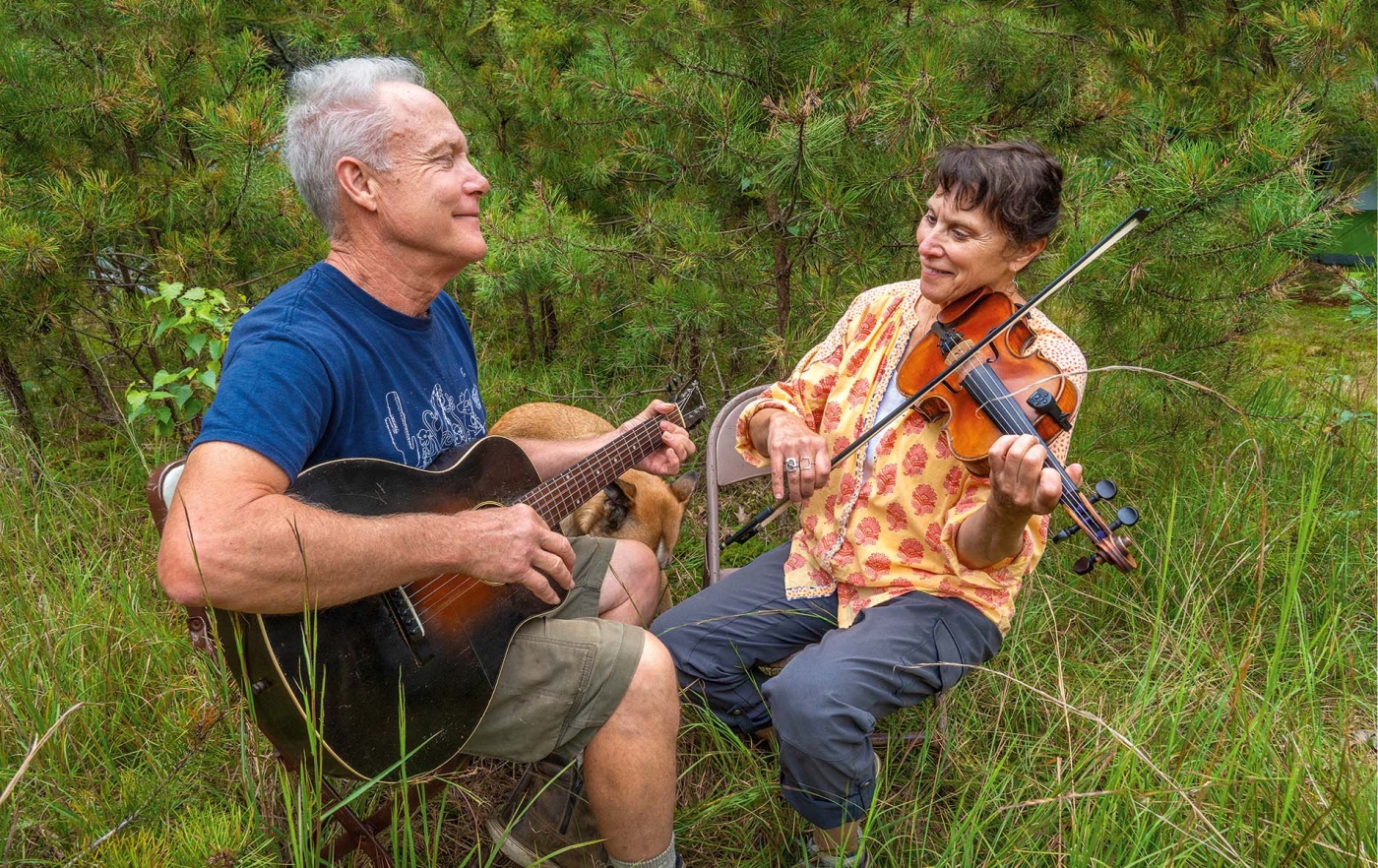High and Lonesome
Old-Time String Band students learn Appalachian music the traditional way—by ear.
In a stuffy room packed with more than 75 Brown students wearing various combinations of denim and boots, the first notes fill the air. In a flurry of fiddles, banjos, and guitars, hands clasp hands. People twirl and do-si-do, beaming at each other as they whirl by.
Unlike most classes at Brown University, the final project for Old-Time String Band—a half-credit class housed in the music department—is a square dance. The course teaches “American (southern Appalachian Mountain) traditional music,” according to its description.
Over the course of the semester, the group acquires 20 tunes for their repertoire, organized by key. The class meets in the evening for two hours a week.

At one such class meeting on a Tuesday evening in the beginning of March, the piercing syncopation of Sandol Astrausky’s fiddle begins the tune. After a few beats, five acoustic guitars, eight fiddles, four banjos, and six ukuleles join in, working their way through the “Green Valley Waltz.” The group wails and croons the verses as the guitars continue strumming, adding harmonies as they go. The only percussion is the steady thumping of Astrausky’s tapping cowboy boot, keeping time and rumbling the scratched wooden floor. She punctuates the tune, sticking out her boot and shouting “last one.”
Just thirty minutes earlier, the members of Old-Time String Band heard this tune for the first time. Rory MacLeod and Astrausky, the teaching associates leading the class, played through the A and B sections a few times as the students mimed the chords and notes on their frets. The class does not use any sheet music, following in the old-time tradition of learning music by ear.
“I’ll try to lead you correctly,” Astrausky laughs. “Sorry if I’m not.”
For a couple of minutes the ensemble isolates each section until the melody and rhythms come together. A few guitar players inquire about the chords, and the fiddle players stumble through the complicated melody.
“If you can’t figure it out, play something,” Astrausky says. “It’s a waltz, so you can do anything you want with it.”
Brown students and community members began taking this class in 1986, when ethnomusicologist Jeff Titon became the head of the PhD program in ethnomusicology. While a professor at Tufts, Titon founded the “first ever old-time string band ethnomusicology ensemble” in 1981, so he was eager to bring it to Brown.
“I simply decided I wanted to do it, and nobody stopped me,” Titon recalls. He describes the class as a “gift to the University” because he was never paid for it. He adds that “this music is a gift”—an idea deeply entrenched in his teaching philosophy.
Astrausky and MacLeod were among the community members who started attending Titon’s class in the late ’80s at a time when community and University classes met together. During their first five years, Astrausky says that they “never missed a class.” The pair subbed in for Titon when he took a sabbatical, and when Titon retired in 2013, they took over.
In 2018, the pair separated the two classes because student demand grew, but some students continued to participate in the community band if they had scheduling conflicts with the class.
MacLeod encourages students of all abilities to try the class. “In the hills of Appalachia, if someone’s uncle was playing on the porch and they got interested, that’s sort of how they learned, just by hearing and learning it,” Mac-Leod explains.
William Loughridge ’26, an Oklahoma native, has played in OTSB for four semesters and decided to pick up a banjo halfway through his involvement. He likes to joke that he didn’t start playing the instrument until he got to Brown. “I’m from a state where they think that people play banjo,” he laughs.
Outside of class, he likes to practice in smaller groups, adding that “the best way to get competent with this music is to keep playing it over and over and over again.”
Providence community members learn the same tunes in their own iteration of the class. On the same Tuesday evening in the beginning of March, an hour and a half before the students arrived, two flannels, three pairs of hiking boots, four beards, and one ponytail jammed.
Robert Smith, a professor emeritus of medicine, picked at the banjo, something he’s been playing for 17 years. He recalls that he “strong-armed” Titon into helping him learn. “He said he didn’t teach music,” Smith says. “I wouldn’t take no for an answer.”
They compromised, and Smith started attending the Old-Time String Band class. He’s been jamming with them ever since. Not only have his banjo skills improved, but Smith also found a community.
“Sandol, Rory, and Jeff Titon are among my best friends,” he says. “I didn’t know any of them before I started playing this music.”
Old-time music seems to have that effect on people: to draw them in. Astrausky and MacLeod met through the music scene in Providence. They were both performing a gig at the public library for the “First Night” New Year’s Eve celebration. Astrausky had been playing the fiddle since she was eight, and at the time MacLeod professionally played the stand-up bass for a range of genres, mainly blues. At first, the pair “didn’t know one tune together,” Mac-Leod says.
“I learned guitar and banjo to be able to play with her,” he adds. The couple has known each other for 30 years, been married for 20, and made music all the way through.
“You probably can tell that playing music with someone that you’re in love with is an added bonus to playing music with just other people,” MacLeod adds. The pair live on 10 acres in Hope Valley, and every summer they host an old-time music festival. They also regularly participate in local old-time sessions in Rhode Island and Connecticut.



